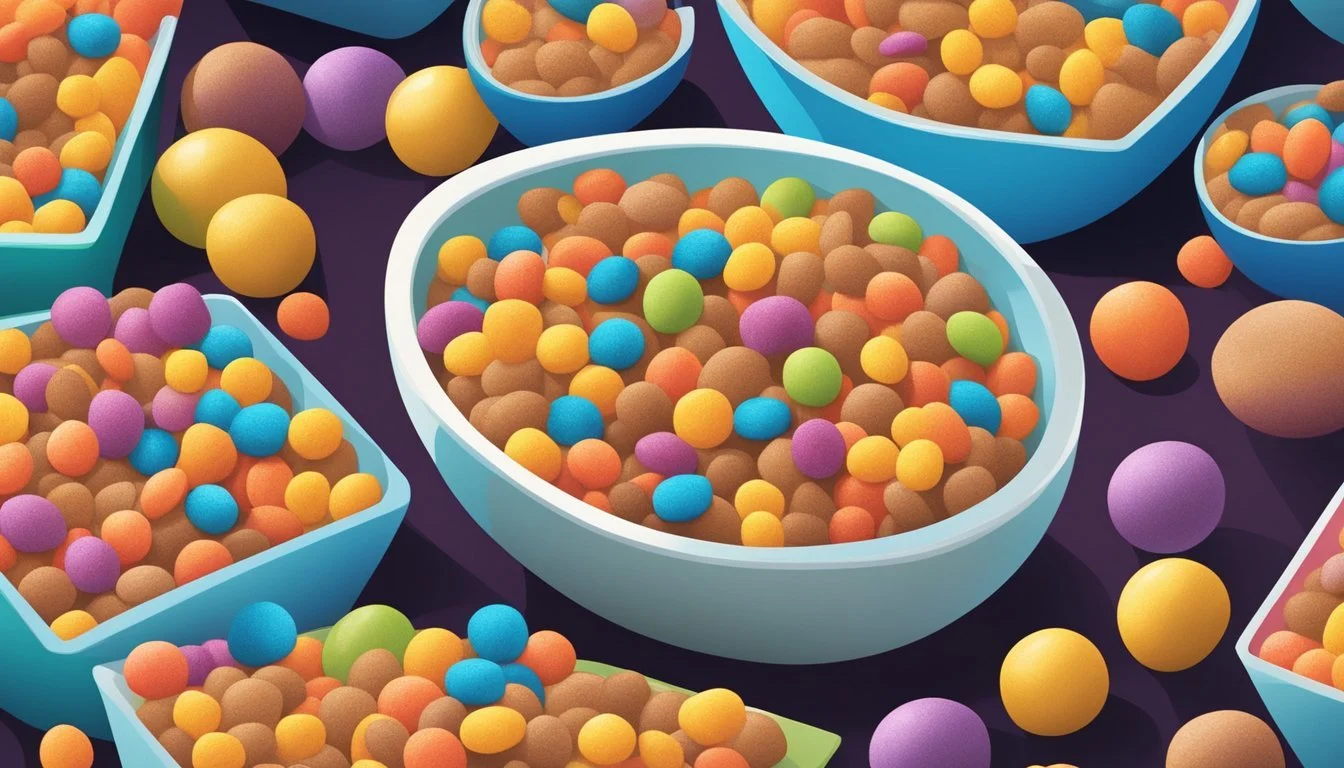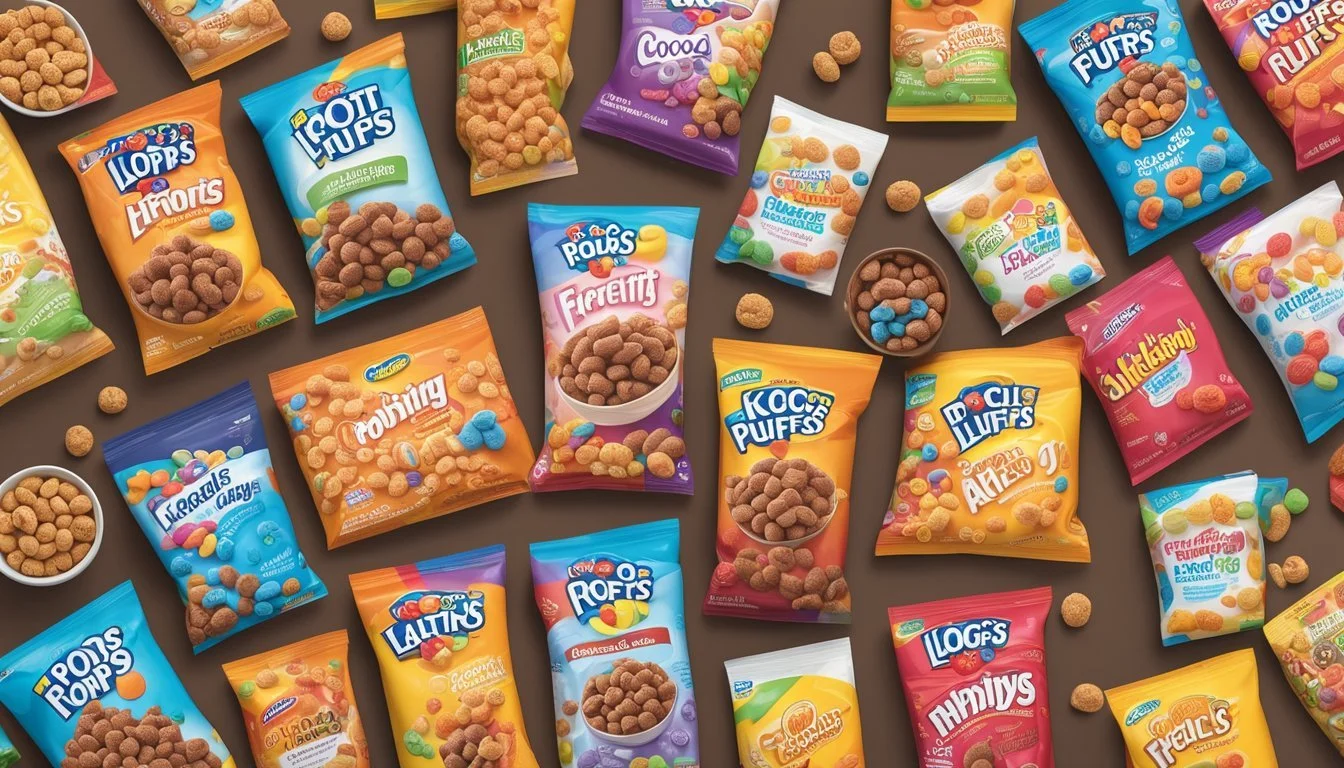Cocoa Puffs vs Kellogg's Froot Loops
A Nutritional and Taste Comparison
This Article is Part of Our Breakfast Cereal Guide with Details on Cocoa Puffs Nutrition and Kellogg's Froot Loops Nutrition
When it comes to choosing between General Mills Cocoa Puffs and Kellogg's Froot Loops for breakfast, the key differentiator lies in their nutritional content and taste preferences. Cocoa Puffs bring a rich, chocolatey flavor to the table, while Froot Loops offer a vibrant, fruity taste that appeals to many. Both cereals are popular choices, especially among children, but the decision often hinges on dietary needs and personal taste.
Vitamin content differs significantly between these two breakfast cereals. For instance, Kellogg's Froot Loops contain twice as much Vitamin C as Cocoa Puffs, making them potentially a better option for those looking to boost their vitamin intake. On the other hand, Cocoa Puffs might be the choice for chocolate lovers who desire a sweeter start to their day.
Considering calories, fat, and sugar is crucial. While both cereals contain sugar, Froot Loops also come with additional nutrients like Vitamin C that Cocoa Puffs lack. Striking the right balance between enjoyment and nutritional benefits is essential for making the best breakfast choice.
Historical Background
Cocoa Puffs and Kellogg's Froot Loops each have distinctive histories, shaped by the competitive breakfast cereal market. Their origins and development provide insight into their longstanding popularity and market presence.
Origins of Cocoa Puffs
Cocoa Puffs was introduced by General Mills in 1958. The cereal was conceived as a chocolate-flavored variant of Kix, another General Mills product. It became instantly recognizable for its rich cocoa flavor and unique puffed corn shape.
The mascot, Sonny the Cuckoo Bird, debuted in 1962, reinforcing the brand's playful image.
Cocoa Puffs stands out for its iconic catchphrase, "I'm cuckoo for Cocoa Puffs!" Through various packaging redesigns and marketing campaigns, the cereal has remained a favorite among chocolate cereal enthusiasts.
Development of Kellogg's Froot Loops
Kellogg's Froot Loops was launched in 1962, following a less-successful cereal, OKs. Froot Loops aimed to attract children with its colorful, ring-shaped pieces and fruity flavors.
Initially, each color of Froot Loops had the same flavor, despite their visual differences.
The cereal's mascot, Toucan Sam, quickly became an enduring symbol. Known for his colorful beak and keen sense of smell, Toucan Sam guided children to the cereal since 1963. Packaging and advertising strategies kept Froot Loops at the forefront of the kids' cereal market for decades.
Both cereals, enriched with vitamins and minerals, have carved their niches in the breakfast cereal landscape.
Nutritional Analysis
Cocoa Puffs and Kellogg's Froot Loops offer distinct nutritional profiles. This analysis delves into their caloric, protein and fiber, as well as vitamin and mineral content.
Caloric Content Comparison
Cocoa Puffs contain approximately 110 calories per serving. Froot Loops also have around 110 calories per serving. The similarity in caloric content makes both cereals comparable in terms of energy intake.
However, comparing the distribution of these calories is key. While both cereals have high sugar content, Cocoa Puffs might have a slightly higher caloric contribution from sugars. A comparative look at these cereals considers not just the number of calories but their sources as well.
Protein and Fiber Content
Cocoa Puffs provide about 1 gram of protein per serving. Froot Loops match this with the same amount. This modest protein content indicates that neither cereal is a significant source of protein.
Fiber content is also quite low in both cereals. Cocoa Puffs and Froot Loops offer minimal dietary fiber, highlighting the importance of incorporating other fiber-rich foods into the diet. Despite their low fiber, both cereals do contribute to daily carbohydrate intake.
Vitamins and Minerals Profile
Kellogg's Froot Loops have 52 mg of Vitamin C per serving compared to the 22.2 mg in Cocoa Puffs. This makes Froot Loops a better source of this essential nutrient.
Both cereals provide similar quantities of iron, essential for blood health, and are fortified with various B vitamins, including B6, B12, and folate. Froot Loops, however, contain a slightly broader array of vitamins.
Zinc, calcium, and vitamin D content are collectively present but not substantially high in either option. The presence of these nutrients underscores the importance of cereal fortification, enhancing their nutritional value beyond basic macronutrients.
Both cereals also contain small amounts of Vitamin A, Vitamin E, and fats largely derived from their ingredients, making them fortified foods with an aim to contribute to better health, albeit with a sugar trade-off.
Ingredient Profile
The ingredients of Cocoa Puffs and Froot Loops vary significantly, impacting their nutritional profiles. Each subsection breaks down the bases, sweeteners, and the prevalence of artificial versus natural ingredients.
Assessment of Cereal Bases
Cocoa Puffs use corn as their primary cereal base. Corn meal, corn syrup, and corn starch are prominent ingredients.
Froot Loops, on the other hand, rely on a blend of corn flour and oat flour. Corn flour and oat flour provide different nutritional compositions compared to Cocoa Puffs.
Cocoa Puffs:
Primary base: Corn
Key ingredients: Corn meal, corn syrup, corn starch
Froot Loops:
Primary base: Blend of Corn and Oat
Key ingredients: Corn flour, oat flour
The choice of base influences texture and flavor, making each cereal unique in experience.
Use of Sugars and Sweeteners
Cocoa Puffs and Froot Loops both contain significant amounts of sugar. Cocoa Puffs include sugar and corn syrup, boosting the sweet flavor.
Froot Loops list sugar, fruit juice concentrates, and corn syrup among their sweeteners. Froot Loops distinguish themselves with a stronger fruity taste profile.
Cocoa Puffs:
Sugars: Sugar, corn syrup
Froot Loops:
Sugars: Sugar, fruit juice concentrates, corn syrup
Both cereals contain added sugars, making them less ideal for those monitoring sugar intake.
Artificial vs Natural Ingredients
Artificial Flavors and Colors are present in both cereals. Cocoa Puffs include artificial flavors to enhance the chocolate taste.
Froot Loops use artificial flavors and colors to create their distinct fruity taste and vibrant appearance. Despite claims for natural ingredients occasionally, the artificial components stand out.
Neither cereal is gluten-free, primarily due to the ingredients used. Both Cocoa Puffs and Froot Loops use artificial ingredients more heavily than natural ones.
Cocoa Puffs:
Flavors: Artificial flavors
Froot Loops:
Flavors: Artificial flavors
Colors: Artificial colors
Consumers preferring natural ingredients may find both cereals lacking in this regard.
These distinctions in cereal bases, sweeteners, and the use of artificial ingredients highlight the different approaches Cocoa Puffs and Froot Loops take in their formulations.
Flavor and Texture Comparison
Flavor: Cocoa Puffs offers a rich cocoa flavor that becomes more pronounced when mixed with milk. The chocolatey taste appeals to those who enjoy a sweeter, dessert-like cereal. In contrast, Froot Loops has a fruity flavor profile. Each loop, regardless of color, carries the same fruit-flavored taste, crafted to be tangy and sweet.
Texture: Cocoa Puffs are crunchy and retain much of their texture even after soaking in milk for a few minutes. The cocoa coating can create a slightly grainy mouthfeel. Conversely, Froot Loops have a lighter, airier texture. They tend to soften faster in milk, making them less crunchy but still pleasant to chew.
Cinnamon and Frosted Notes: Froot Loops do not contain cinnamon or a frosted coating, sticking to their signature fruit flavor. Cocoa Puffs, too, do not incorporate cinnamon but are enveloped in a thin layer of cocoa, adding to the overall chocolate experience.
Cocoa Puffs:
Flavor: Chocolate
Texture: Crunchy, retains crispness in milk
Milk Effect: Enhances cocoa taste
Froot Loops:
Flavor: Fruity
Texture: Light and airy, softens quickly in milk
Milk Effect: Maintains fruit flavor
Both cereals present distinct flavors catering to different taste preferences, with Cocoa Puffs focusing on a deep chocolate experience and Froot Loops delivering a burst of fruity sweetness. Their textures complement their flavors, providing varied experiences when consumed with or without milk.
Health Impact
Cocoa Puffs and Froot Loops differ significantly in their nutritional profiles, influencing their effects on diet and suitability for specific dietary needs.
Effects on Diet and Nutrition
Cocoa Puffs and Froot Loops are both high in carbohydrates. Typically, Froot Loops contain more sugars, which can affect blood sugar levels more drastically. A higher sugar content may not be ideal for those managing diabetes or monitoring their glycemic index.
Comparatively, Cocoa Puffs may have a slightly lower sugar content but still contain enough to warrant moderation. Neither cereal is particularly high in fats, making them poor sources of essential fatty acids but suitable for low-fat diets.
The two cereals also differ in vitamin content. For example, Froot Loops include a higher Vitamin C content, providing added nutritional value. Calories are similar between the two, making the choice between them negligible in terms of caloric intake.
Considerations for Specific Diets
For those on a low-carb diet, both cereals are generally unsuitable due to their high carbohydrate content. A low glycemic index diet would also exclude these options since the high sugar content in both cereals could spike blood sugar levels. Froot Loops, with higher sugar, may be less preferable.
In a low-calorie diet, occasionally consuming these cereals is manageable if portions are carefully controlled. Yet, neither offers a significant nutritional benefit to those seeking low-glycemic or low-carb options.
For individuals on a low-fat diet, both choices fit as they are low in fats. Neither cereal contains significant cholesterol, making them suitable for those monitoring cholesterol intake. Still, the high sugar content raises concerns about overall heart health.
Thus, specialized diets often exclude both cereals due to their high carbohydrate and sugar contents. Each cereal has slight nutritional benefits but overall lacks the qualities needed for strict dietary adherence.
Market Analysis
Kellogg's Froot Loops and General Mills Cocoa Puffs have both established significant market shares, leveraging unique pricing strategies and facing competition from other popular cereal brands. Understanding how these cereals compare in terms of pricing and their alternatives provides insights into their market dynamics.
Pricing and Value
Kellogg's Froot Loops often falls into the mid-range price category. Froot Loops's price per box usually ranges from $3 to $5, depending on the store and promotions.
Cocoa Puffs, produced by General Mills, generally costs slightly less, typically ranging from $2.50 to $4.50. This competitive pricing strategy can make Cocoa Puffs more attractive to budget-conscious consumers.
Both cereals frequently offer discounts and promotions, especially on retail platforms like Amazon. Furthermore, bulk purchasing options can significantly alter pricing dynamics, adding value for larger families or frequent buyers.
Comparing Popular Market Alternatives
Several other cereals compete with Kellogg's Froot Loops and General Mills Cocoa Puffs in the ready-to-eat category. Notable competitors include Cheerios, Frosted Flakes, and Honey Nut Cheerios.
Cheerios offers a different nutritional profile, often marketed as a heart-healthy option suitable for all ages. Frosted Flakes, another Kellogg's product, provides a sugary alternative but with an established nostalgic appeal.
Honey Nut Cheerios remains popular due to its balance of sweetness and whole grain benefits.
Consumers gravitate towards these alternatives based on diverse factors, including taste preferences, nutritional content, and brand loyalty, which significantly influence the market positioning of Froot Loops and Cocoa Puffs.
Consumer Preferences
Consumers often choose cereals based on taste, brand loyalty, and nutritional benefits. In comparing General Mills Cocoa Puffs and Kellogg's Froot Loops, it's clear that both brands have their unique followings and appeal to different sensibilities within the market.
Trends in Cereal Consumption
Recent trends highlight a growing preference for healthier breakfast options. Shoppers are increasingly reading labels and comparing nutritional content before making a purchase decision. This shift is partly driven by a more health-conscious public. Kellogg's Froot Loops is favored for its higher Vitamin C content, while General Mills Cocoa Puffs is often chosen for its classic chocolate flavor.
Despite the rise in health-conscious decisions, nostalgic favorites like Cocoa Puffs and Froot Loops maintain their market position due to established consumer habits. For instance, cereals with added fiber like Apple Jacks and Lucky Charms are seeing a boost, but not enough to overshadow household names.
Brand Loyalty and Recognition
Kellogg's and General Mills both benefit from strong brand loyalty. Shoppers often stick with the brands they grew up with. This loyalty is reinforced by consistent marketing and brand visibility. Kellogg's Froot Loops benefits from colorful and engaging packaging, appealing especially to children.
Adults tend to gravitate towards brands like General Mills Cocoa Puffs due to nostalgic connections to their childhood. These emotions significantly influence repeat purchases. Both brands invest in marketing campaigns that reinforce their products' identities, keeping them top of mind for consumers.
The iconic mascots associated with these cereals—like the toucan for Froot Loops and the cuckoo bird for Cocoa Puffs—also contribute to strong brand recognition and consumer loyalty.
Dietary Considerations and Allergies
When choosing between Cocoa Puffs and Kellogg's Froot Loops, it is crucial to consider potential allergens and suitability for various dietary restrictions. These factors are important for ensuring safe and compatible consumption.
Gluten and Allergen Information
Cocoa Puffs and Kellogg's Froot Loops are not marketed as gluten-free cereals. Therefore, individuals with celiac disease or gluten sensitivity should avoid these products. Both cereals contain common allergens such as wheat and may contain traces of nuts, soy, and dairy.
Cocoa Puffs:
Contains wheat and soy.
Froot Loops:
Contains wheat and soy.
May contain milk derivatives.
Reading ingredient labels carefully is essential for those with severe allergies. Consult the latest packaging information to confirm the presence or absence of specific allergens before purchasing.
Suitability for Restricted Diets
Neither Cocoa Puffs nor Froot Loops are designed for restricted diets such as keto or those requiring organic ingredients. Both cereals contain added sugars and carbohydrates, making them unsuitable for low-carb or ketogenic diets.
Froot Loops:
Contains 52 mg of Vitamin C per serving.
Provides 2 grams of dietary fiber per serving.
Cocoa Puffs:
Lacks dietary fiber.
Contains 22.2 mg of Vitamin C per serving.
These cereals are not classified as Non-GMO or organic. Consumers seeking products that comply with specific dietary restrictions should look for specialty cereals that are labeled accordingly.
Innovations in Cereal Products
Recent years have seen significant advancements in cereal products, with a focus on healthier options and the rise of alternative brands that challenge traditional cereal choices. These innovations cater to a wide range of dietary preferences and health-conscious consumers.
Advancements in Healthy Cereal Options
Healthier cereal alternatives have become increasingly popular as consumers seek nutritious breakfast choices. High-protein cereals, for instance, offer a substantial protein boost to start the day. Brands like Magic Spoon, known for their Fruity Cereal, emphasize high-protein content without compromising taste.
Grain-free options have also gained traction. These cereals often use ingredients like tapioca and other non-grain substitutes to cater to low-carb or paleo diets. Such products appeal to those with gluten sensitivities or who wish to reduce grain intake.
Another innovation is the use of natural sweeteners such as monk fruit. This zero-calorie sweetener is a healthier alternative to sugar, making cereals both tasty and low in added sugars. Organic ingredients are also more prevalent, as consumers look for cleaner, less processed foods in their diets.
The Rise of Alternative Cereal Brands
Alternative cereal brands are revolutionizing the market by offering unique and specialized products. Companies like Magic Spoon provide cereals that are not only healthy but also flavorful, appealing to adults who grew up with sugary cereals yet want healthier options.
Many of these brands focus on catering to specific dietary needs. For example, some brands specialize in grain-free cereal options that utilize tapioca and other non-grain sources. These brands also frequently employ innovative ingredients to maintain taste and texture while meeting dietary restrictions.
Organic cereals are another growing segment. Consumers are increasingly aware of the benefits of organic farming and seek products that reflect those values. Brands emphasizing organic ingredients provide peace of mind regarding the absence of pesticides and synthetic additives.
In summary, the cereal market is evolving to meet the demands of health-conscious consumers and those with specialized dietary needs, providing a diverse range of innovative products.
Environmental and Ethical Considerations
When evaluating Cocoa Puffs and Kellogg's Froot Loops, environmental and ethical considerations are significant factors.
Non-GMO products are increasingly favored by consumers who are concerned about environmental sustainability. Both General Mills and Kellogg’s have made strides in offering Non-GMO options, but it's important to verify each product to confirm its Non-GMO status.
Organic Ingredients are another crucial factor. Cereals like Cocoa Puffs and Froot Loops typically do not use organic ingredients. Organic farming practices can be more sustainable and better for the ecosystem. Consumers seeking environmentally friendly options should check the labels for organic certifications.
Packaging is another area of concern. Cereals often come in plastic bags within cardboard boxes. Consumers should appreciate efforts by companies to use recyclable materials and reduce plastic use. Both General Mills and Kellogg’s have initiatives to improve packaging sustainability, but the extent varies.
Labor Practices also play a role in ethical considerations. Companies must ensure fair labor practices throughout their supply chains. General Mills and Kellogg’s have corporate social responsibility programs, but it's beneficial to review their transparency reports to assess their commitments.
Animal Welfare can be relevant for ingredients such as milk or gelatin used in fortified cereals. Checking for cruelty-free certifications can provide peace of mind to conscientious consumers.
For those who prioritize environmental and ethical aspects, it’s advisable to regularly review company updates and consider products certified by recognized environmental and ethical standards.
More on Cocoa Puffs
More on Kellogg's Froot Loops
Cinnamon Toast Crunch vs Kellogg's Froot Loops: Which is better?
French Toast Crunch vs Kellogg's Froot Loops: Which is better?
Honey Nut Cheerios vs Kellogg's Froot Loops: Which is better?
Kellogg's Apple Jacks vs Kellogg's Froot Loops: Which is better?
Kellogg's Froot Loops vs Post GrapevsNut Flakes: Which is better?
Kellogg's Froot Loops vs Post Raisin Bran Cereal: Which is better?








